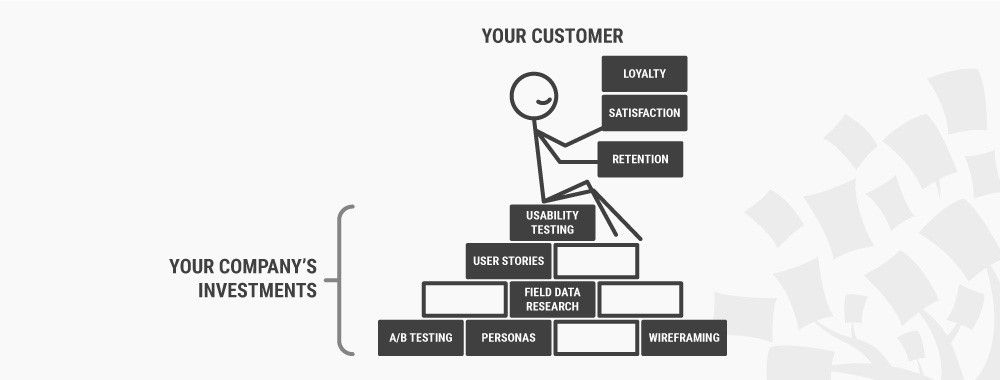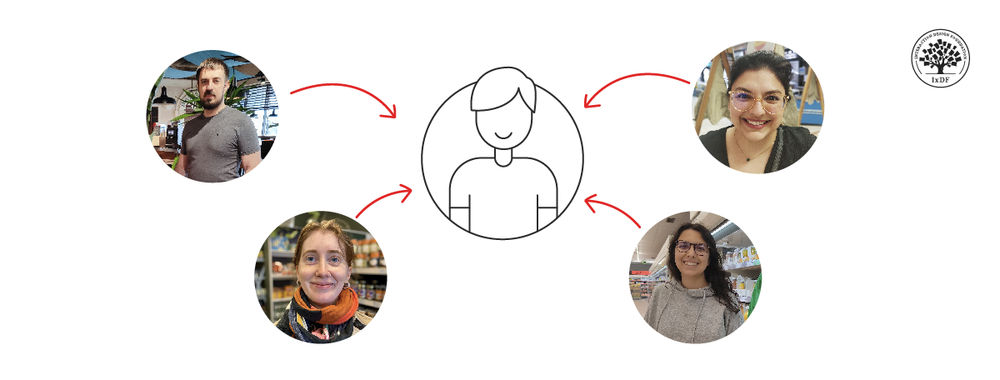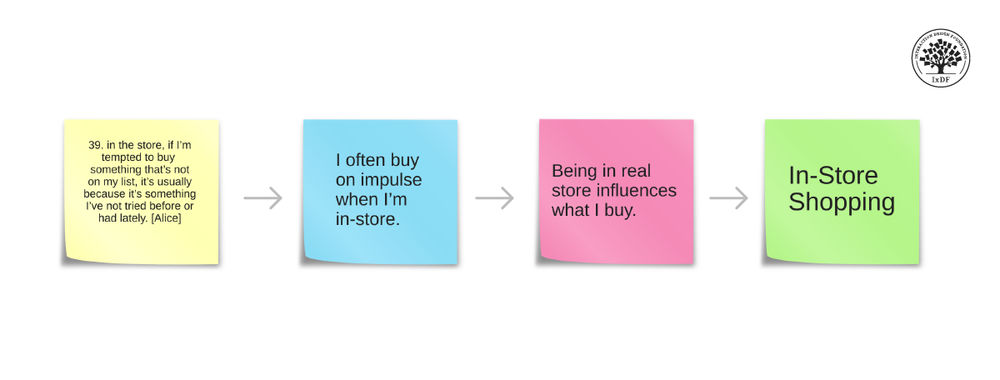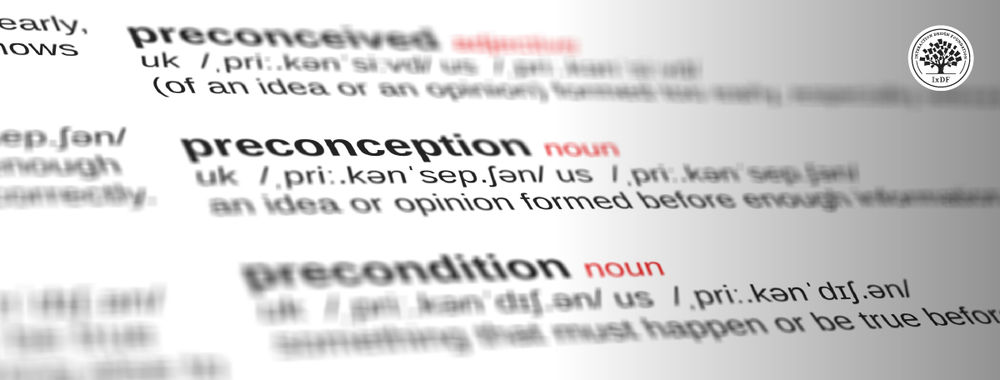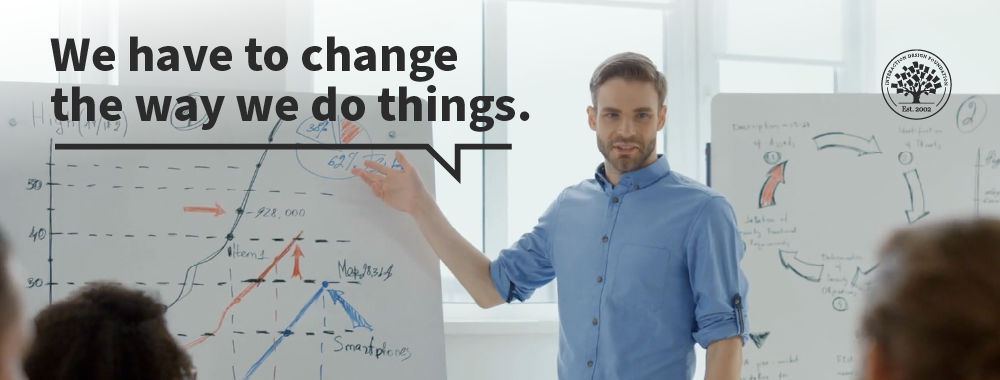When User Experience (UX) improves the customer experience, it affects the company’s ROI (Return on Investment) because good UX investments enhance customer satisfaction. Satisfied customers are loyal; they trust a company’s products, and they want to come back for more, which is why satisfied customers are vital to a company’s success – and are its very reason for existing. Here, you’ll learn which steps you can specifically take to boost your customers’ satisfaction—and likewise your company’s ROI—through investments in specific UX techniques and work processes.
Table of contents
- UX, Customer Satisfaction and ROI Go Hand in Hand at Amazon and Etsy
- 5 key ROI Areas from UX
- 3 Essential UX Techniques which will Improve your Customers’ Experience and Your Company’s ROI
- When UX Improves the Customer Experience, It Affects ROI Significantly
- How Much ROI Can You Expect – UX Metrics and KPIs
- When Should You Invest in UX?
- 5 Steps to Usability ROI
- User Experience from Your Customers’ Perspective
- Problems with ROI
- The Take Away
- Want to Learn more? Two Online Courses that will Take You to the Next Level
- References and Where to Learn More
- Images
UX, Customer Satisfaction and ROI Go Hand in Hand at Amazon and Etsy
Let’s start with the classic example of Amazon before we delve any further. Amazon is a prime example of a company that has built its success and ROI upon a focus on customer experience throughout the entire customer journey and that continually measures the user experience. Amazon founder and CEO, Jeff Bezos, argues that it is better to have a long-term focus on customer experience than a short-term focus on profit – often to the chagrin of Amazon shareholders, who would prefer profit here and now. In a 2013 letter to shareholders, he answered some of his critics, saying:
“…I think long-term thinking squares the circle. Proactively delighting customers earns trust, which earns more business from those customers, even in new business arenas. Take a long-term view, and the interests of customers and shareholders align.”
The global online marketplace Etsy is a good example of a company that has built its success on a focus on customer experience throughout the entire customer journey and that continuously measures the user experience.
For example, Etsy routinely tests different versions of user interfaces to constantly improve the platform’s usability as well as business metrics. Etsy's continued position as one of the largest online marketplaces is a result of its rigorous focus on usability, research and testing.
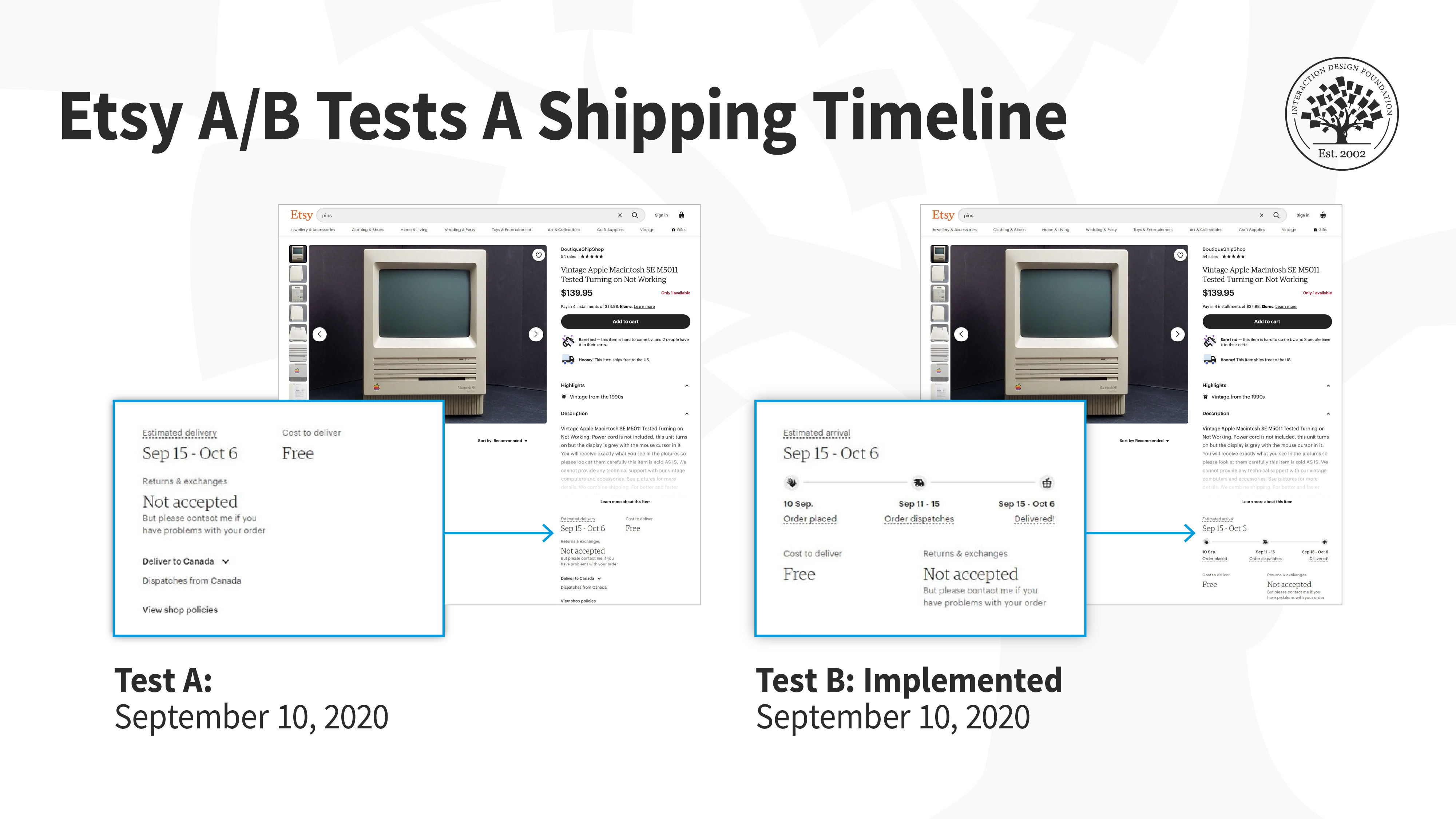
The world’s most successful companies continually test and iterate their products, as is evident in their A/B tests. Here is one of several that GoodUI has been tracking. You can see more such “leaked” tests from AirBnb, Amazon, Booking, Netflix and others on their website.
© Etsy and GoodUI, Fair Use
5 key ROI Areas from UX
When a company invests more in the user experience of its products or website, it can improve the ROI in five overall areas:
Boosted overall revenue/conversion – because of greater ease of use, better emotional attachment to the brand, and resulting customer loyalty.
Increased customer satisfaction, also business-to-business satisfaction – because customers love well-designed products that give them what they need and want (and what they don’t know they need and want).
Lower support calls – because pre-empting so many likely user problems via UX techniques lowers the company’s costs.
Reduced development waste – which increases development efficiency and thus saves money in the development phase.
Reduced risk of building the wrong thing! User research is a tool to find out what your customers will find to be the most usable and valuable things.
The return on investment in good UX is undeniably huge. While calculating the ROI of design efforts is difficult, some organizations have attempted to do so by analyzing the net effect that a focus on design has on the overall profitability of a company.

The Design Management Institute, for instance, has found that design-centric companies (such as Apple, Coca-Cola and IBM) outperformed the S&P index (which indicates the industry’s average performance) by 228% over a 10-year period from 2003 to 2013. That’s even before considering the internal cost savings that come with greater productivity, reduced redundancy in workflows, lowered development and maintenance costs, and many other factors.
©Frank Spillers and Experience Dynamics, CC BY-SA 3.0
Let’s get a bit more specific. Return on investment (ROI) is a financial metric used to analyze the efficiency of an investment. ROI = the profit from an investment (investment cost) and is usually expressed as a percentage. For instance, if you invest $1,000 in creating a website and it increases your sales by $1,500, then the ROI = (1,500 - 1,000)/1,000 = 50%.
In this piece, we use ROI more broadly to describe the effect of an investment in a design-related area—e.g., investments in customer experience, design, usability or user research. When used in this way, ROI cannot be calculated as simply as in finance, because the investment is not always measured in the same unit as the benefit, and the effect is not always direct. In design projects, we often measure investment in money or time, but you can also measure increased customer satisfaction, improved user efficiency or the reduction of user error—all of which will most likely lead to an indirect rise in profits.
3 Essential UX Techniques which will Improve your Customers’ Experience and Your Company’s ROI
When MacAfee started integrating usability testing to learn more about its customers and their needs, the company saved 90% in support expenses costs. How can you integrate UX more deeply in your company’s workflows and work culture to improve the customer experience and increase ROI? Well, for example, you can perform field studies and build personas of your customers and raise your ROI by up to 4 times, as the UX and marketing teams can provide the development team with specific customer information at the very beginning of the design process.
Frank Spillers is the CEO of the award-winning UX firm Experience Dynamics and also a course instructor at the Interaction Design Foundation. In the video below, he will explain the ROI of integrating three essential user experience techniques: personas, wireframing & prototyping and usability testing.
Frank Spillers especially focuses on the ROI of these three essential user experience techniques:
Personas – These are fictional characters which you create based on your field data research and field studies to represent the different user types who might use your service, product, site or brand in a similar way. Creating personas will help you understand your users’ needs, experiences, behaviors and goals. It’s a powerful way to gain vital insights, given that it can help you step out of yourself. Creating personas can help you not only to recognize that different people have different needs and expectations, but also to identify with the users you’re designing for. It’s a great idea to model critical scenarios: Scenario-driven design is about understanding your customers—namely, their experience, context, tasks, needs and desires—in sharp relief and plugging those fine details into a scenario which you can then model. Scenarios are the probability captured of what you’re trying to do. Then, taking the scenarios, you can build user stories, personas and customer journey maps.
Wireframing – A wireframe is a low-fidelity, basic layout of and series of structural guidelines for your web product's layout in the form of, for example, paper sketches – and rapid prototyping, which is an advanced wireframewith more visual detail and interaction such as, for example, interactive digital mock-ups.
Usability Testing – This is a technique for evaluating a product by testing it on users when you want to know how easy a design is to use. This group of representative customers will yield powerful insights through their interactions with and reactions to your design. Usability testing supplies direct knowledge about how real customers use the system because it involves observing customers as they attempt to complete tasks. It is often something a company conducts repeatedly, from early-stage development until a product’s release. The main benefit and purpose of usability testing is to identify usability problems with a design as early as possible, so they can be fixed before implementing or mass producing the design. In view of this, usability testing is often conducted on prototypes rather than finished products. Remember to create measurable business goals –e.g., use AB test targets to improve registration, newsletter sign ups, etc. It’s also essential to identify barriers to user success by using analytics, AB testing and user testing.
When UX Improves the Customer Experience, It Affects ROI Significantly
Customer intelligence agency Walker has predicted that experience will overtake price and product as the key brand differentiator by 2020. Jeff Bezos built Amazon’s success upon a focus on customer experience throughout the entire customer journey and a philosophy of continuously measuring the user experience. Likewise, Google, Airbnb and Intuit have integrated User Experience into the core of their work processes. Why? It’s because a good user experience will boost:
Customer loyalty
Customer satisfaction
Customer retention
and it will strengthen: Brand loyalty.
Additional ways UX Improves ROI
Reduced time to market (production/development)
Improved leadership position
Improved job performance
Increased employee retention
Savings in labor costs (in the development department and in the support department)
Reduction in inventory
How Much ROI Can You Expect – UX Metrics and KPIs
What should you expect from your UX efforts? And how much money should you prioritize investing in UX to increase your company’s ROI significantly? In the video below, Frank Spillers will answer those questions, and he’ll present Jacob Nielsen’s key research results. Jacob Nielsen found that when UX improves the customer experience, it raises a company’s KPIs (Key Performance Indicators) up to 83% in conversion lift. Nielsen is a User Advocate and principal of the Nielsen Norman Group, which he co-founded with grand old man of UX, Don Norman.
When Should You Invest in UX?
The simple answer is – as early on as you possibly can. As Clare-Marie Karat, a principal UX consultant and former IBM researcher, stated:
“A rule of thumb is for every one dollar invested in User Experience research you save $10 in development and $100 in post-release maintenance.”
According to this, the 1:10:100 rule for change, it will cost you $1 to do initial research, $10 to change your design and $100 to change your product. Clare-Marie Karat was a Research Staff Member at the IBM T. J. Watson Research Center through 2009. She now consults with the Karat Consulting Group.
It is far less expensive to avoid designing a problematic product in the first place than to fix it later.When organizations invest in UX during a project’s concept phase, they reduce product development cycles by 33 to 50 percent. This is vital; a one-fourth delay in the amount of time it takes to bring a product to market results in a 50-percent loss of that product’s profit. In software, where about 5 percent of features are used 95 percent of the time, UX can really enhance the focus on feature sets and dramatically improve the outcome.
However, what’s vital to bear in mind is that UX techniques should be a part of the workflows during the entire development process. Designing in a vacuum should never be an option. As your product is to end up in the hands of customers, you’ll need to ensure the continuity of a user-centric focus – continuously testing your design on those representative customers keeps the spotlight where it should be. From there, not only will it help you prevent many “growing pains” for your product later on; you’ll find it tends to be a strategy that pays dividends in other ways, too. Moving forward in the users’ shoes every step of the way will make your organization far more relevant and trustable.

For managers, it’s important to understand that if you fail quickly, you’ll save time and money in the development phase.
©Frank Spillers and Experience Dynamics, CC BY-SA 3.0
5 Steps to Usability ROI
So, how do you grow your usability ROI? You always start with the business objectives, your mission and your value. Then you establish your usability metrics for your product. It may not just be the ease-of-use driver; it could also be the ease-of-learning one. The third step is to gather baseline data by, for example, performing usability testing or web analytics. The fourth step is to monitor the progress and/or conduct A-B Testing. Finally, it’s crucial that you monitor the post-project success on an ongoing basis. What was your target, and what really happened? Don’t just move on to the next project; stay put and learn from your previous ones – each is a data mine.
User Experience from Your Customers’ Perspective
When we look at user experience from your customers’ perspective, we find three positive levels of customer satisfaction. You can meet your customers’ expectations by giving them what they expect. You can step up one level and exceed their expectations, and start earning your customers’ trust and loyalty. And then you can shape their expectations, as—for instance—Google did when it continuously exceeded its customers’ expectations by earning loyalty via the trusted search bar “I’m feeling lucky”. That trust built the foundation for Google to start shaping the customers’ expectations, and that’s a major reason Google was successfully able to launch new products such as Google Sheets and, later, the Android phone.

There are three positive levels of customer satisfaction. As a company, you can meet your customers’ expectations by giving them what they expect. You can step up a level and exceed their expectations and start earning your customers’ trust and loyalty. From there, you can shape their expectations.
©Frank Spillers and Experience Dynamics, CC BY-SA 3.0
First of all, a critical consideration is for your product to meet your customers’ needs and expectations. It has to be highly usable, look good, feel good, and feel the way your customers expect it to. If you meet your customers’ expectations, they’ll feel that your company cares about them. Your product will feel familiar to them – something they’ll not only own with pride but also feel good about whenever they think about it.
If you meet and exceed your customers’ expectations, they will start trusting you. You’ll earn their loyalty. They’ll start spreading positive vibes about your product to their family members and friends. The bond you will have created with them will also translate to ratings and reviews – the power of social proof is unquestionably immense.
Shape is the sweet spot. This is where your customers feel that they want to buy more. They want to come back. The customers are open to suggestions regarding new functionality and maybe even brand extension. You saw that with Google. Google built its search engine and met its users’ expectations for about ten years, and then it started bringing out new free products—e.g., Google Sheets—before finally launching the Android phone. The customer trust was there. The loyalty was there. Google built its customers’ trust and loyalty over years and years of systematically meeting and exceeding their expectations. Frank Spillers terms this Expectation Engineering – when a company continuously meets and exceeds customers’ expectations.
Problems with ROI
Let’s take a closer look at complications with ROI. It’s important to bear in mind that ROI is an estimate and, for all its strong points, significant problems come with its use:
ROI fails to discount cash flows and to take account of any risk or variation in the timing of financial costs and returns.
ROI is not seen as a key indicator, even though most companies use it that way. ROI is really a trailing indicator.
ROI could be measured inconsistently across an organization.
Timing for return on investment is often missing or off because it’s often difficult to know when precisely to start and stop the assessment of the return on investment.
The Take Away
ROI is an assessment technique that evaluates capital expenditures. It assesses what a company can gain from an investment. In our case, we’re focusing on what we can expect to get back from improving the customer experience by implementing user experience techniques such as personas, prototyping, wireframing and usability testing.
When should you start? As soon as you can: not designing a problematic product in the first place is far less expensive than having to fix it later. Learning about your customers upfront before you start coding and building is easier and pays dividends in other ways, too. It’s simply good business to integrate UX early in the product development cycle and test the users’ experience and satisfaction time and again as you proceed. That’s why UX has become a staple for software development teams. The 1:10:100 rule for change encapsulates this: Spend 1 dollar early on in research by using e.g. personas and prototypes… or spend 10 dollars on changing the design later… or wait and spend 100 dollars on changing the product.
What should you expect from your UX investments? If you spend 10% of the development budget on UX, you’ll get 83% in conversion lift – according to Jacob Nielsen’s research. When UX improves the customer experience, it increases a company’s KPIs (Key Performance Indicators) up to 83% in conversion lift. If UX is not improving KPIs and ROI, though, then it’s not good UX.
Want to Learn more? Two Online Courses that will Take You to the Next Level
If you want to dive further into this topic, you can take your knowledge base—and your ability to implement it—to the next level by learning directly from Frank Spillers, the instructor on the UX Management: Strategy and Tactics course. Many of the guidelines and insights in this piece come just from this course. In it, you can explore the ins and outs of UX maturity by looking at the way your organization is structured and developed. We will give you the chance to grasp UX management as not just a people issue but also a design methodology… all so that you can manage UX as a smart leader, and get the very best from the UX professionals you work with. It’s no coincidence that top-performing organizations succeed partly because they place a focus on understanding and empowering their UX and UI teams.
If you want to expand your knowledge on User Experience, you can follow the online course User Experience: The Beginner’s Guide. Throughout this course, you will gain a thorough understanding of the various design principles that come together to create a user’s experience when using a product or service. When you work with user experience, having a solid grasp of what those areas are is crucial so that you know what tools are available to you.
References and Where to Learn More
Westcott, M. (2014). “Design-driven companies outperform S&P by 228% over ten years – The ‘DMI Design Value Index’”. DMI (Design Management Institute).
Friis Dam, R. and Teo, Y. S. (2018). “Personas – A Simple Introduction”. Interaction Design Foundation.
Karat, C-M. (2005). Cost-Justifying Usability, Ph.D. from the IBM T. J. Watson Research Center.
Pressman, R. (2005 6th ed./1982). Software Engineering: A Practitioner’s Approach. McGraw Hill.
Walker Information (2013). “Customers 2020: The Future of B-to-B Customer Experience.”
Strategic Data Consulting (2009). “Special Report: UX Business Impacts and ROI; 735 companies surveyed”.
Hines, M. (2013). “Getting Started with A/B Testing”. (AppStore Blog).
Mortensen, D. (2018). “User Research: What It is and Why You should do It”. Interaction Design Foundation.
Souza, R. K. (2001)."Get ROI from Design". Cambridge: Forrester Research.
Images
Hero Illustration: © Interaction Design Foundation, CC BY-NC-SA 3.0
